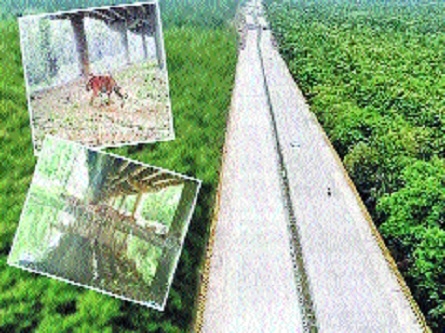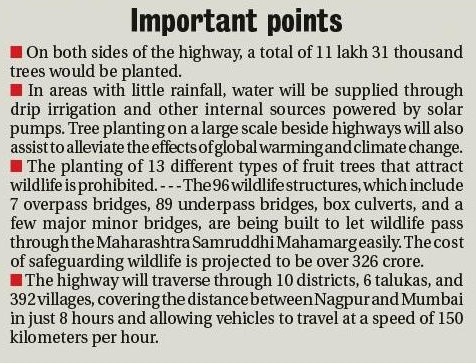Samruddhi Mahamarg to have over 11 lakh trees on both sides
21 Jul 2021 09:27:09

Principal Correspondent :
In a landmark decision to reduce accidents caused by wildlife infiltration, India’s fastest highway, Maharashtra Samruddhi Mahamarg is limiting planting of fruit trees alongside the road. The 96 wildlife structures including overpass bridges, underpass, box culvert and a few other major and minor bridges on Maharashtra Samruddhi Mahamarg will ensure that wildlife activity in the surrounding area is not affected. The Hindu Hruday Samrat Balasaheb Thackeray Maharashtra Samruddhi Mahamarg, India’s fastest highway and Maharashtra's most ambitious project, is being meticulously designed.

A total of 11.31 lakh trees will be planted on both sides of the highway. Maharashtra State Road Development Corporation (MSRDC) has prohibited planting of 13 varieties of fruit trees that attract wildlife, including Mango, Cashew, Java Plum, Orange, Citrus, and Date Palms. The Wildlife Institute of India (WWI), which is active in biodiversity research around the country, is collaborating in the construction of the Commenting on the development, Ekanth Shinde, Minister of Urban Development Department, Government of Maharashtra, said, “Our aim is to make people’s travel from Mumbai to Nagpur faster, convenient and seamless. The construction of Maharashtra Samruddhi Mahamarg is moving swiftly, and more emphasis has been placed on minimizing environmental destruction. Cultural, conserved forests, protected regions, and wildlife sanctuaries will also be enhanced in order to boost tourism in the region. A ‘Green and Scenic Corridor’ will also be created as part of the project.” The Maharashtra Samruddhi Mahamarg will also include large walls that will serve as noise barriers.
These walls would stand an average 4 meter tall. These will be installed at multiple locations alongside the highway to prevent upsetting the natural habitat and wildlife in the surrounding area. Ornamental plants will also be placed on the highway barrier. The large-scale tree planting along the highways will also help to mitigate the consequences of global warming and climate change. A drip irrigation system that catches and stores rainwater will irrigate all of the trees and water will be supplied through internal water sources using solar pumps in places with minimal rainfall. The plants will be inspected by a monitoring system based on geological studies, with tree adoption being the primary goal. The project also intends to nurture plants on a regular basis for the next five years after planting. Nagpur, Wardha, Amravati, Washim, Buldhana, Jalna, Aurangabad, Ahmednagar, Nashik, and Thane would be connected by this highway. 14 more districts will be linked to the highway indirectly via interchanges. This will result in the large-scale growth of adjacent districts and communities. Eknath Shinde, the Minister of Urban Development Department, is sure that the Maharashtra Samruddhi Mahamarg will boost the state's infrastructure and the economy.
